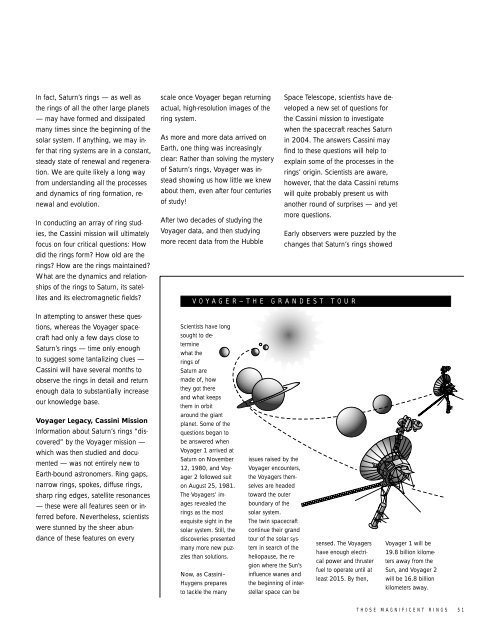Passage to a Ringed World - NASA's History Office
Passage to a Ringed World - NASA's History Office
Passage to a Ringed World - NASA's History Office
Create successful ePaper yourself
Turn your PDF publications into a flip-book with our unique Google optimized e-Paper software.
In fact, Saturn’s rings — as well as<br />
the rings of all the other large planets<br />
— may have formed and dissipated<br />
many times since the beginning of the<br />
solar system. If anything, we may infer<br />
that ring systems are in a constant,<br />
steady state of renewal and regeneration.<br />
We are quite likely a long way<br />
from understanding all the processes<br />
and dynamics of ring formation, renewal<br />
and evolution.<br />
In conducting an array of ring studies,<br />
the Cassini mission will ultimately<br />
focus on four critical questions: How<br />
did the rings form? How old are the<br />
rings? How are the rings maintained?<br />
What are the dynamics and relationships<br />
of the rings <strong>to</strong> Saturn, its satellites<br />
and its electromagnetic fields?<br />
In attempting <strong>to</strong> answer these questions,<br />
whereas the Voyager spacecraft<br />
had only a few days close <strong>to</strong><br />
Saturn’s rings — time only enough<br />
<strong>to</strong> suggest some tantalizing clues —<br />
Cassini will have several months <strong>to</strong><br />
observe the rings in detail and return<br />
enough data <strong>to</strong> substantially increase<br />
our knowledge base.<br />
Voyager Legacy, Cassini Mission<br />
Information about Saturn’s rings “discovered”<br />
by the Voyager mission —<br />
which was then studied and documented<br />
— was not entirely new <strong>to</strong><br />
Earth-bound astronomers. Ring gaps,<br />
narrow rings, spokes, diffuse rings,<br />
sharp ring edges, satellite resonances<br />
— these were all features seen or inferred<br />
before. Nevertheless, scientists<br />
were stunned by the sheer abundance<br />
of these features on every<br />
scale once Voyager began returning<br />
actual, high-resolution images of the<br />
ring system.<br />
As more and more data arrived on<br />
Earth, one thing was increasingly<br />
clear: Rather than solving the mystery<br />
of Saturn’s rings, Voyager was instead<br />
showing us how little we knew<br />
about them, even after four centuries<br />
of study!<br />
After two decades of studying the<br />
Voyager data, and then studying<br />
more recent data from the Hubble<br />
Scientists have long<br />
sought <strong>to</strong> determine<br />
what the<br />
rings of<br />
Saturn are<br />
made of, how<br />
they got there<br />
and what keeps<br />
them in orbit<br />
around the giant<br />
planet. Some of the<br />
questions began <strong>to</strong><br />
be answered when<br />
Voyager 1 arrived at<br />
Saturn on November<br />
12, 1980, and Voyager<br />
2 followed suit<br />
on August 25, 1981.<br />
The Voyagers’ images<br />
revealed the<br />
rings as the most<br />
exquisite sight in the<br />
solar system. Still, the<br />
discoveries presented<br />
many more new puzzles<br />
than solutions.<br />
Now, as Cassini–<br />
Huygens prepares<br />
<strong>to</strong> tackle the many<br />
issues raised by the<br />
Voyager encounters,<br />
the Voyagers themselves<br />
are headed<br />
<strong>to</strong>ward the outer<br />
boundary of the<br />
solar system.<br />
The twin spacecraft<br />
continue their grand<br />
<strong>to</strong>ur of the solar system<br />
in search of the<br />
heliopause, the region<br />
where the Sun’s<br />
influence wanes and<br />
the beginning of interstellar<br />
space can be<br />
Space Telescope, scientists have developed<br />
a new set of questions for<br />
the Cassini mission <strong>to</strong> investigate<br />
when the spacecraft reaches Saturn<br />
in 2004. The answers Cassini may<br />
find <strong>to</strong> these questions will help <strong>to</strong><br />
explain some of the processes in the<br />
rings’ origin. Scientists are aware,<br />
however, that the data Cassini returns<br />
will quite probably present us with<br />
another round of surprises — and yet<br />
more questions.<br />
Early observers were puzzled by the<br />
changes that Saturn’s rings showed<br />
VOYAGER—THE GRANDEST TOUR<br />
sensed. The Voyagers<br />
have enough electrical<br />
power and thruster<br />
fuel <strong>to</strong> operate until at<br />
least 2015. By then,<br />
Voyager 1 will be<br />
19.8 billion kilometers<br />
away from the<br />
Sun, and Voyager 2<br />
will be 16.8 billion<br />
kilometers away.<br />
THOSE MAGNIFICENT RINGS 51
















